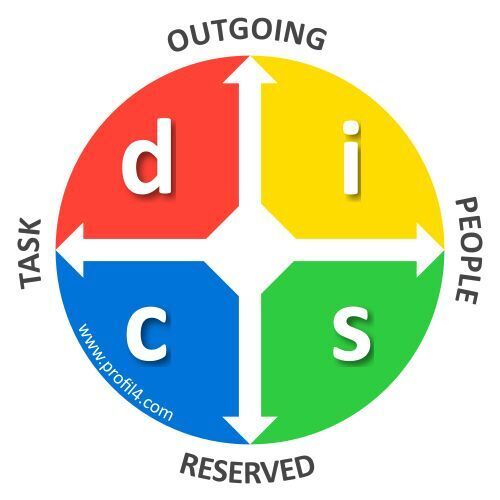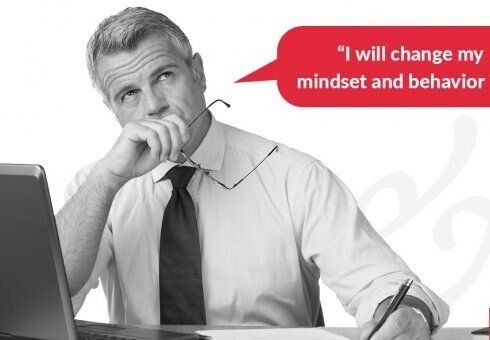BLOG
Blog

door Jordi van Berkum
•
22 april 2022
An article in the newspaper of “Financieel Dagblad” of Tuesday 12 April stated that regardless of the sector, companies are faced with higher cost increases and that these organizations, especially in the SMB sector, are increasingly absorbing the cost increases themselves and not passing them on to their customers. This is understandable, since after years of moderate price developments, companies are no longer trained in this. Sellers like to make deals, but not to tell customers that the price is going up.

door Jordi van Berkum
•
13 april 2022
"Impacted by latest trends the B2B buying process has changed, has your customer approach followed?" Not so long ago you could do very well in selling if you were good at asking questions to understand your customers’ needs and then tailoring your solution to these needs and presenting your solution in a compelling way. Times have changed. Buyers are much better informed through business tools like the internet. Sales is invited later and later into the decision-making process and customers are spending less time meeting with suppliers. Gartner research finds that when B2B buyers are considering a purchase‚ they spend only 17% of that time meeting with potential suppliers. Often customers have already identified their issues, defined their needs, and already defined their best solutions or solution criteria. They might just ask you to meet those specifications, at the lowest price possible and buyers then create price competition between different suppliers. There is a clear reason why more and more companies are issuing tenders for more and more of their purchases. Another trend is that there are more people involved in a B-to-B purchase decision than ever before. Latest research by Gartner indicates that the average number of decision influences in major B-to-B purchase decisions has increased to between 6 to 10 people. Often the next major challenge is determining how to help create consensus amongst the decision influences, to ensure that a buying decision will be made and made in your favor. This is key, as practice shows that in more and more buying situations your customer is prepared to postpone or even cancel major buying decisions. During the past Covid years the contact with customers has dramatically changed as before the Covid-19 pandemic most of the sales appointments were conducted face-to-face. In 2017, in-person selling appointments made up over 70% of the sales force, research by Xant suggests. People were accustomed to it. People are now used to seeing products through product demo videos and are open to the convenience of video calls. This is predicted to continue long-term or even never to go away. Gartner says that 80% of B2B sales interactions between suppliers and buyers will occur in digital channels by 2025. It will become even harder for sales to create the same connection with their customer, as it is more difficult to read the body language. The screen can act as a disconnector, so it is crucial to be organized to also be able to make an emotional connection virtually with the decision makers at your customers. As a result of these trends sales organizations are confronted with challenges which will hinder them to meet 2022 sales objectives: 1. Price pressure, 2. Drying opportunity pipeline, 3. Low conversion ratio and/or 4. Long sales cycles Do you recognize one or more of these challenges? I, as partner consultant with Hovingh & Partners, help people and organizations (internationally) to overcome these challenges by supporting the development of their sales organizations into the best performing in their markets. Best performing sales organizations do something different than their less successful colleagues. In the limited time they are given to spend with their customer they are very capable of challenging the customer's thinking process. They change their customer's view of their problems and are able to challenge the customer in their thinking. They are Masters in discovering latent pain, understanding the Critical Business Issues and are able to find a way to help the customer address them. They change and form the solution picture of the expected partnership with their customers. By doing so, they position themselves as an expert and trusted advisor with whom their customer likes to talk and trust. Their sales are able to make a personal connection as well through face-to-face as virtual contact. Please contact me if you would like to discuss your challenges within your market segment(s) and obstacles your sales team is daily dealing with on your road to success. What's needed to handle or take away these obstacles in the most efficient en effective way. Please contact me through LinkedIn Messaging or mail (jordi.vanberkum@hovingh.eu)

door Jordi van Berkum
•
13 april 2022
All things being equal, people buy from people they LIKE. All things not being so equal, people STILL buy from people they like. Most sales reps, account managers and client directors generally sell in the way they like to be sold too. Most of us have learned that we need to “treat others like you want to be treated”. Is this actually true? Is this what we need to do in order to be liked by the other person and to be able to build solid and trusted relationships? The fact is, we are all different, we have different personalities, values, convictions, styles, and drivers. If we would really understand the other, we could adapt, and our effectiveness would significantly increase. What if you would be able to recognize personality types, behavior, and styles? What if you would better understand personal drivers (goal and fear) of the other? It would be very helpful in daily live and especially in selling, would it not? DISC will help you first to better understand yourself. You will also learn to identify the other persons personality type and how to deal with different styles to increase your effectiveness during face to face and virtual customer interaction. DISC really helps you to create rapport and establish a real deep connection with your customer especially on an emotional level. That’s fundamental, as people buy from people they LIKE, trust and respect.

door Jordi van Berkum
•
13 april 2022
Waarom veranderen altijd weerstand oproept en wat je daartegen kunt doen. De mens is een gewoontedier die kijkt naar rolmodellen! De visie en de plannen voor de komende tijd zijn helder. Directie en salesmanagement zijn het eens over glasheldere targets. En dan is er alleen nog een minor detail: de accountmanagers moeten de beoogde successen scoren. Een nieuw rondje salestrainingen bij het vaste bureau - want zij kennen de organisatie al zo goed – houdt iedereen fris en vaardig, en zo komt het allemaal goed. Toch? Bíjna goed… Salestraining: de intentie is juist, maar het effect is anders dan je denkt. Verkopen blijft een uiterst relevant vakgebied. Ook nu in het online tijdperk, want belangrijke deals worden echt niet met een klik van de muis via het winkelmandje gesloten. Training en opleiding zijn daarom de geijkte manier om verkoopprofessionals goed uitgerust voor hun taak te houden. Dat is vaak ook nodig omdat het verloop in salesorganisaties behoorlijk hoog is. Een prima manier om teamgeest te kweken dus. Maar wat iedereen stilzwijgend accepteert is dat het rendement van het geleerde vrijwel nihil is. Tsjah? Op z'n best is er tijdelijk een positief effect na een training, maar uiteindelijk wint de praktijk het van de trainingssessies. De logische oplossing bij veel organisaties, is weer een nieuw rondje trainingen in te plannen. Tsjah?.... Wanneer het gaat om een blijvend effectieve salesorganisatie, dan is er wezenlijke verandering nodig. Niets minder. Waarom trainingen niet beklijven Als verkoper in een training kan je even uit de klantmodus. Bij een hotel of conferentieoord tref je in een zaaltje een handjevol collega’s aan, en een bevlogen trainer die het allemaal weer even goed neerzet. De ervaren rotten noteren hier en daar wat hen zinnig lijkt, maar denken er verder het hunne van. Nieuwe mensen komen met frisse vragen en na de lunch met broodjes kroket en andere hartige hap wordt het tijd voor actie met oefeningen om de middagdip tegen te gaan. Eenmaal terug op kantoor verdwijnt de gevulde multomap in de bureaula. Want nu gaat het weer om échte klanten. Waarom gebeurt dit en waarom het blijft gebeuren? Uitdaging nummer 1: de mens is een gewoontedier Wanneer het gaat om een blijvend effectieve salesorganisatie, dan is er wezenlijke verandering nodig. Niets minder. Helaas gaan mensen niet zomaar mee in een verandertraject. Daar zijn heel valide redenen voor. Achter veel weerstand, maar ook tijdrovende aanpassingen bij welwillende personen, schuilt een essentiële oorzaak: de mens is een gewoontedier. Hoezo? Energie: Wij mensen zijn enorm efficiënt gebouwd en uitgerust om zoveel mogelijk energie te sparen. Nieuwe dingen doen kost dus energie die we niet zomaar geven. Aandacht: Uit veel onderzoek blijkt dat 95% van ons gedrag onbewust is. Nieuwe vaardigheden in praktijk brengen vraagt om bewust handelen. Herhaling: Nieuwe gewoontes aanleren gaat niet over een nacht ijs. Om een nieuwe gewoonte te ontwikkelen moet je de handeling zo’n 66 tot 250 keer doen. Als manager en als organisatie zijn er een aantal zaken die je zal moeten doorvoeren om wél tot een verankering van nieuw en succesvol gedrag te komen. Uitdaging nummer 2: A zeggen en B doen Een belangrijke factor om tot de verankering van nieuw en succesvol gedrag te komen, is de aanwezigheid van rolmodellen. Dat betekent dat je als sales manager het niet op een training kan afschuiven, maar dat je een belangrijke rol hebt in de verandering die je wilt zien bij je verkopers . In een groep nemen mensen bewust en onbewust het gedrag over van iemand die zij als voorbeeld zien. Je kunt meer bereiken door de gewenste verandering zélf te laten zien dan door het ene te zeggen en het andere te doen. In het tweede geval bereik je ook wat, alleen niet in de gewenste richting. Door bewust te zijn van je rol kan je veel tijd, geld en moeite besparen. Vier elementen voor verandering In ons whitepaper over de blijvend effectieve salesorganisatie doen wij uitgebreid uit de doeken welke vier elementen zorgen voor werkelijke transformatie. Dit staat geworteld in het bewezen McKinsey Model of Change. Bij grote, internationale verkooporganisaties hebben wij deze aanpak met succes toegepast. Het enige is dat je er als organisatie voor kiest om de nodige veranderingen door te voeren. Hetzelfde doen en een ander resultaat verwachten is geen optie. Blijvend succes is echt een keuze... Kies jij voor blijvend succes?

door Jordi van Berkum
•
13 april 2022
In this blog I will give the four reasons why your CRM will not ensure an improved sales process. And how you can achieve that! In the field of CRM, there are extensive systems that, as market leader Salesforce indicates, are widely used for contact management, productivity purposes and sales management. And that's exactly where it goes wrong. Because organizations that want to teach their sales team new sales skills think they can enforce this by recording the process steps in CRM. This is a good start, but it is far from sufficient to bring sustainable change. How do you use CRM when you want to develop your team with (new) sales skills? In this blog, I will give you four reasons why your CRM won't improve your sales process (and how you can!). 1. A ruler is not a jumping stick CRM systems are ideal for recording data and tracking results. That's how they were developed: as a well-documented module for relationship management. However, we see that CRM systems are often 'misused' to (co-)create results instead of measuring results. This is done by enforcing process steps and desired behavior from salespeople via the CRM system. However, making certain fields in your CRM mandatory does not lead to different behaviors. In this case, CRM as a ruler is used as a jumping stick. There is of course something improper in this because cause and effect are reversed here. It is therefore not surprising that this only gives better results to a certain extent. 2. Administrative burden or added value? Following the right steps in sales processes will indeed show an improvement in conversion rates, for example from appointment to quotation and from quotation to assignment. However, most CRM systems are not designed to really help salespeople put new skills (read: behaviors) into practice. As a result, it is making the job of the salespeople in your team more complicated, and the CRM system is mainly seen as an administrative burden. The skills that salespeople have learned in training cannot be enforced through fill-in exercises in the CRM system. 3. Better conversion rates, but is it really getting better? Many top managers use information from analyses out of CRM data as a tool to boost sales. In their pursuit of improving sales results, it is then tempting to address poor performers first. But the effect of this "approach" is often not what you had hoped for. For many salespeople it becomes a special art to fill the CRM system to expectations. You as a manager will then see what has been recorded: many activities. But are the sales results better? An improvement in conversion rates from lead to appointment or from appointment to quote will certainly become visible. But the ultimate conversion, from quotation to assignment, immediately deteriorates. Because the number of orders remains the same while the number of visits and quotations that are registered rise to the sky. First of all, sales require skills. Registration of customer activities is at most a tool, but it cannot offer structural improvement. 4. From steering on KPIs to proactive coaching Growth and skill development require the right mindset and the practice of new behaviors. How tempting is it to go back to old behavior when you must achieve short-term KPIs, and you are held accountable for them? Pretty tempting, right? The most effective method is not to focus as a sales manager on punishing lesser KPI results, but to coach your people to keep trying. And to support them to practice. By giving your sales reps the confidence that they always know more than their customer and don't have to worry that they will be judge by them if they don't execute the new skills perfectly, you help them through an essential phase of adoption and growth to a higher level. If you don't get through this, you'll be stuck in the existing level. Help, challenge, and practice Sales skills that salespeople have learned in a training cannot be enforced through fill-in exercises in the CRM system. But by continuing to help and challenge them a lot to practice on what they have learned and by giving them the confidence that the customer will not judge them if they do not do it perfect yet. Practice is the only way to really become proficient and too structurally improve the conversion into orders. Would you like to know more about embedding a higher level in the sales organization, coaching and talent development through a proven successful approach?



